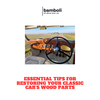How to Restore Your Classic Car's Wooden Dashboard: A Step-by-Step Guide

How to Restore Your Classic Car's Wooden Dashboard: A Step-by-Step Guide
Welcome to our step-by-step guide on how to restore your classic car's wooden dashboard! If you are a car enthusiast or vintage car owner, you know the importance of maintaining the original beauty and charm of your vehicle. Over time, the wooden dashboard of a classic car can start to show signs of wear and tear, losing its luster and elegance. However, with the right tools and techniques, you can bring back its former glory and enhance the overall appearance of your beloved vehicle. In this guide, we will walk you through the process of restoring your classic car's wooden dashboard, helping you preserve its authenticity and timeless appeal. Let's get started!
Assessing the Condition of Your Classic Car's Wooden Dashboard
Classic cars, the wooden dashboard is often a standout feature that adds a touch of elegance and sophistication. However, over time, the wooden dashboard can deteriorate due to various factors such as age, moisture, and sunlight exposure. It is important to regularly assess the condition of your classic car's wooden dashboard to ensure its longevity and maintain its beauty.
Here are some steps to help you assess the condition of your classic car's wooden dashboard:
- Visual Inspection: Carefully examine the wooden dashboard for any visible damage such as cracks, warping, or discoloration. These may indicate that the wood is deteriorating and needs attention.
- Touch Test: Run your fingers along the surface of the wooden dashboard to feel for any rough spots or unevenness. Smooth surfaces are a good sign of a well-maintained dashboard.
- Smell Check: A musty or moldy odor coming from the wooden dashboard could indicate moisture damage. This needs to be addressed promptly to prevent further deterioration.
By regularly assessing the condition of your classic car's wooden dashboard, you can identify any issues early on and take the necessary steps to preserve its beauty and ensure its longevity. Remember, proper maintenance is key to preserving the charm and elegance of your classic car's wooden dashboard.
Choosing the Right Type of Wood for Your Dashboard Restoration
Restoring the dashboard of your car is a rewarding project that can bring new life to your vehicle's interior. One of the key decisions you'll need to make during the restoration process is selecting the right type of wood for the dashboard. The type of wood you choose will not only impact the aesthetic appeal of your dashboard, but also its durability and longevity.
Factors to Consider When Choosing Wood for Dashboard Restoration:
When selecting wood for your dashboard restoration, consider the following factors:
|
Factor |
Consideration |
|
1. Type of Wood |
Choose a wood that is durable and can withstand the temperature and humidity changes inside your car. |
|
2. Aesthetic Appeal |
Select a wood that complements the overall look and feel of your vehicle's interior. |
|
3. Maintenance |
Consider the maintenance requirements of the wood you choose and make sure it is easy to clean and maintain. |
Some popular wood choices for dashboard restoration include walnut, mahogany, and teak. These woods are known for their durability and beautiful grain patterns, making them ideal for enhancing the look of your dashboard. Ultimately, the best type of wood for your dashboard restoration will depend on your personal preferences and budget.
By carefully considering the type of wood for your dashboard restoration, you can ensure that your project is a success and that your car's interior looks stunning for years to come.
Preparing the Wooden Surface for Restoration
Restoring old wooden furniture or surfaces can be a rewarding project that brings new life to cherished pieces. However, before diving into the restoration process, it is crucial to properly prepare the wooden surface to ensure the best results. Here are some steps to follow when preparing a wooden surface for restoration:
- Clean
Before starting any restoration work, it is essential to thoroughly clean the wooden surface. Use a mild detergent or wood cleaner to remove dirt, grime, and any old finish that may be present. This step is critical as it helps to create a clean canvas for the restoration process.
- Sand
Once the surface is clean and dry, sanding is the next step in preparing the wood for restoration. Sanding helps to remove any unevenness, scratches, or imperfections on the surface. Start with a coarse sandpaper and gradually work your way up to a finer grit for a smooth finish. This step is essential for achieving a professional-looking result.
- Repair
After sanding, inspect the wooden surface for any cracks, holes, or damage that needs to be repaired. Use wood filler or epoxy to fill in any imperfections and let it dry completely before sanding again. This step is crucial for ensuring the structural integrity of the wood before proceeding with the restoration process.
By following these steps to prepare the wooden surface for restoration, you can ensure that your project will turn out beautifully and stand the test of time.
Remember, proper preparation is key to a successful restoration project!
Applying Wood Stain and Finish to Revitalize Your Dashboard
Over time, the dashboard of your car can start to look worn out and faded. One way to revitalize it and bring back its original shine is by applying wood stain and finish. This process can help protect the dashboard from further damage and give it a fresh, new look. Here are some steps to guide you through the process:
Materials Needed:
Before you start, make sure you have the following materials:
|
Materials |
Description |
|
Wood stain |
Choose a color that matches your dashboard |
|
Wood finish |
Helps protect the wood from wear and tear |
|
Sandpaper |
For sanding the dashboard surface |
|
Brushes |
To apply the stain and finish |
Steps to Apply Wood Stain and Finish:
- Clean: Start by cleaning the dashboard thoroughly to remove any dirt or grime.
- Sand: Use fine-grit sandpaper to sand the surface of the dashboard. This will help the stain adhere better.
- Apply Stain: Using a brush, apply the wood stain evenly on the dashboard. Let it dry completely.
- Apply Finish: Once the stain is dry, apply a coat of wood finish to protect the dashboard.
- Repeat: If needed, repeat the staining and finishing process for a deeper color and added protection.
By following these steps, you can easily revitalize your dashboard and give it a fresh, new look. Remember to choose high-quality wood stain and finish products for the best results. Enjoy your newly refreshed dashboard!
Polishing and Buffing Techniques for a Professional Finish
Achieving a professional finish on your workpiece, polishing and buffing are essential techniques that can make a world of difference. Whether you are working on metal, wood, or any other material, the right polishing and buffing techniques can help you achieve a smooth, glossy surface that is free from imperfections. In this article, we will discuss some of the best practices for polishing and buffing to help you achieve that professional finish you desire.
Preparation
Before you begin polishing and buffing, it is important to prepare your workpiece properly. This includes cleaning the surface thoroughly to remove any dirt, debris, or contaminants that could interfere with the polishing process. Additionally, you may need to sand the surface to smooth out any rough spots or imperfections that could affect the final finish. Remember, preparation is key when it comes to achieving a professional finish.
Polishing
Polishing is the first step in achieving a professional finish. This process involves using a polishing compound and a polishing wheel to remove any scratches, blemishes, or imperfections on the surface of your workpiece. It is important to work in small, circular motions and apply even pressure to ensure a consistent finish. Remember, patience and attention to detail are essential when it comes to polishing.
Buffing
Once you have finished polishing, the next step is buffing. This process involves using a buffing wheel and a buffing compound to bring out the shine and gloss of your workpiece. Similar to polishing, it is important to work in small, circular motions and apply even pressure to achieve a uniform finish. Remember, the final buffing stage is crucial in achieving that perfectly polished and professional look.
By following these polishing and buffing techniques, you can achieve a professional finish that will impress even the most discerning eye. Remember, practice makes perfect, so don't be afraid to experiment with different techniques and tools until you find what works best for your specific project. With patience, attention to detail, and a little bit of elbow grease, you can achieve a professional finish that will elevate your work to the next level.
Maintaining the Beauty of Your Restored Wooden Dashboard
Restoring a wooden dashboard can bring a classic and elegant look to your car interior. However, to ensure that the beauty of your restored wooden dashboard lasts, it is important to properly maintain it. Here are some tips to help you keep your wooden dashboard looking its best.
Cleaning
Regular cleaning is essential to prevent dirt and dust from accumulating on the surface of your wooden dashboard. Use a soft microfiber cloth to gently wipe down the dashboard, removing any debris. Avoid using harsh chemicals or abrasive materials that can damage the wood.
Moisture Control
Wood is sensitive to changes in moisture levels, so it is important to keep the interior of your car at a consistent humidity level. Avoid leaving your car parked in direct sunlight for extended periods, as this can cause the wood to dry out and crack. Consider using a car dehumidifier to control moisture levels inside the vehicle.
Protective Coating
Applying a protective coating to your wooden dashboard can help to enhance its natural beauty and protect it from damage. Consider using a high-quality wood polish or varnish to add a layer of protection to the surface of the wood. Be sure to follow the manufacturer's instructions for application.
Remember, proper maintenance is essential to preserve the beauty of your restored wooden dashboard.
|
Tip |
Description |
|
Cleaning |
Use a soft cloth to gently wipe down the dashboard. |
|
Moisture Control |
Avoid leaving your car in direct sunlight to prevent wood damage. |
|
Protective Coating |
Apply a protective coating to enhance the beauty of the wood. |
Frequently Asked Questions
What is the purpose of the blog article?
The purpose of the blog article is to provide information about the topic.
How can readers benefit from reading the blog article?
Readers can benefit by gaining valuable insights and knowledge on the subject.
Is the information in the blog article up-to-date?
Yes, the information in the blog article is up-to-date as of the publication date.
Are there any references or sources cited in the blog article?
Yes, the blog article contains references and sources to support the information provided.
Can readers reach out for further questions or inquiries?
Readers can reach out for further questions or inquiries by contacting the author through the provided contact information.




